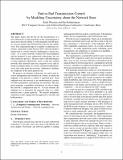| dc.contributor.author | Winstein, Keith J. | |
| dc.contributor.author | Balakrishnan, Hari | |
| dc.date.accessioned | 2011-11-16T13:38:09Z | |
| dc.date.available | 2011-11-16T13:38:09Z | |
| dc.date.issued | 2011-11 | |
| dc.identifier.isbn | 978-1-4503-1059-8 | |
| dc.identifier.uri | http://hdl.handle.net/1721.1/67032 | |
| dc.description.abstract | This paper argues that the bar for the incorporation of a
new subnetwork or link technology in the current Internet is
much more than the ability to send minimum-sized IP packets:
success requires that TCP perform well over any subnetwork.
This requirement imposes a number of additional constraints,
some hard to meet because TCP’s network model is
limited and its overall objective challenging to specify precisely.
As a result, network evolution has been hampered
and the potential of new subnetwork technologies has not
been realized in practice. The poor end-to-end performance
of many important subnetworks, such as wide-area cellular
networks that zealously hide non-congestive losses and introduce
enormous delays as a result, or home broadband networks
that suffer from the notorious “bufferbloat” problem,
are symptoms of this more general issue.
We propose an alternate architecture for end-to-end resource
management and transmission control, in which the
endpoints work directly to achieve a specified goal. Each
endpoint treats the network as an nondeterministic automaton
whose parameters and topology are uncertain. The endpoint
maintains a probability distribution on what it thinks
the network’s configuration may be. At each moment, the
endpoint acts to maximize the expected value of a utility
function that is given explicitly. We present preliminary
simulation results arguing that the approach is tractable and
holds promise. | en_US |
| dc.description.sponsorship | National Science Foundation (U.S.) (CNS-1040072) | en_US |
| dc.language.iso | en_US | |
| dc.publisher | Association for Computing Machinery | en_US |
| dc.relation.isversionof | http://conferences.sigcomm.org/hotnets/2011/program.shtml | en_US |
| dc.relation.isversionof | http://dblp.uni-trier.de/db/conf/hotnets/hotnets2011.html | |
| dc.rights | Creative Commons Attribution-Noncommercial-Share Alike 3.0 | en_US |
| dc.rights.uri | http://creativecommons.org/licenses/by-nc-sa/3.0/ | en_US |
| dc.source | Keith Winstein | en_US |
| dc.title | End-to-End Transmission Control by Modeling Uncertainty about the Network State | en_US |
| dc.type | Article | en_US |
| dc.identifier.citation | Winstein, Keith and Hari Balakrishnan. "End-to-End Transmission Control by Modeling Uncertainty about the Network State." In: Proceedings of the Tenth ACM Workshop on Hot Topics in Networks (Hotnets X), November 14-15, 2011, Cambridge, Mass. | en_US |
| dc.contributor.department | Massachusetts Institute of Technology. Computer Science and Artificial Intelligence Laboratory | en_US |
| dc.contributor.department | Massachusetts Institute of Technology. Department of Electrical Engineering and Computer Science | en_US |
| dc.contributor.approver | Balakrishnan, Hari | |
| dc.contributor.mitauthor | Balakrishnan, Hari | |
| dc.contributor.mitauthor | Winstein, Keith J. | |
| dc.relation.journal | Proceedings of the Tenth ACM Workshop on Hot Topics in Networks (Hotnets X) | en_US |
| dc.eprint.version | Author's final manuscript | en_US |
| dc.type.uri | http://purl.org/eprint/type/ConferencePaper | en_US |
| dspace.orderedauthors | Winstein, Keith J.; Balakrishnan, Hari | en_US |
| dc.identifier.orcid | https://orcid.org/0000-0002-1455-9652 | |
| mit.license | OPEN_ACCESS_POLICY | en_US |
| mit.metadata.status | Complete | |
